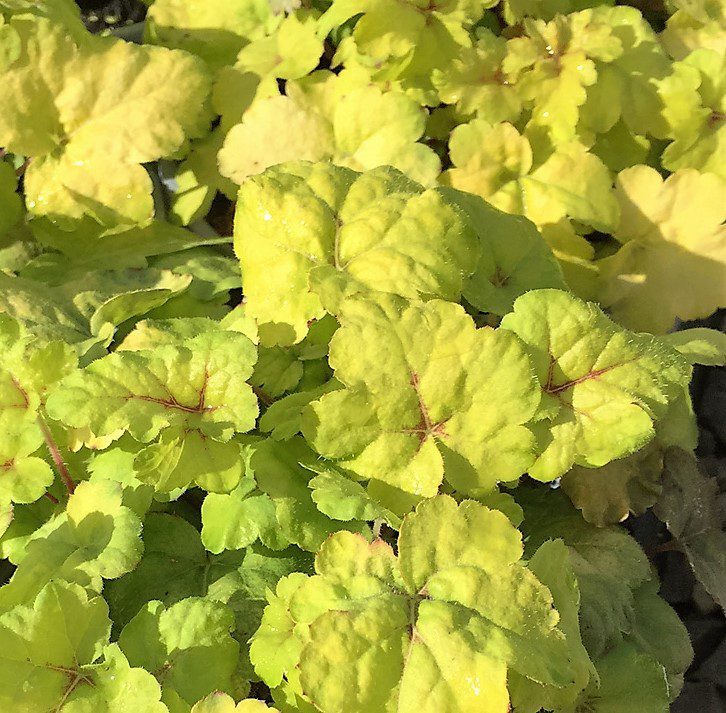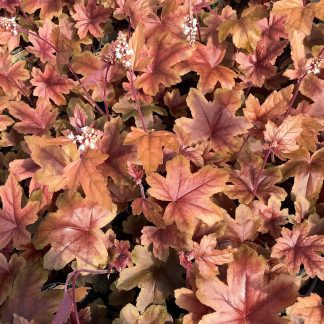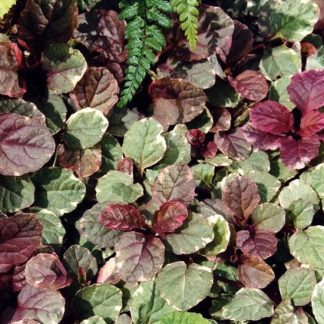Description
Heucherella ‘Stoplight’: The Friendly Glow in Your Shade Garden
Welcome
We all love a plant that turns heads. Heucherella ‘Stoplight’ does just that, but in a kind way. Its bright leaves glow in dim corners. The plant is easy to grow, and it greets us with cheer from spring to fall. In this deep-dive guide, we explore every part of ‘Stoplight’. We look at what makes it special, how to grow it, and how to let it shine beside our other garden friends. Settle in, and let’s bring new light to your shade bed.
Meet Heucherella ‘Stoplight’
Heucherella is a mix of two genera—Heuchera and Tiarella. Think of it as the best of both parents. ‘Stoplight’ is famous for bold, chartreuse-yellow leaves with a red center. The name fits. The colors pop like a traffic light on a gray day. Each leaf is shaped like a small maple, with neat points that catch any sunbeam that slips through.
In other words, this plant acts like a living highlighter. It marks dark corners and says, “Look here!” But most of all, it stays bright even in summer heat, which many other yellow plants cannot do.
Quick Snapshot
- Hardiness: USDA Zones 4–9
- Mature Size: 8 inches tall, 18 inches wide
- Bloom Time: Late spring to early summer
- Flower Color: Soft white or pale pink sprays
- Foliage Highlight: Neon yellow leaves with vivid red star at the center
A Closer Look at the Leaves
The leaves are the show. When they first emerge in spring, they glow lemon-yellow. A bold crimson star spreads from the veins. As temperatures rise, the yellow may deepen to lime, yet the red remains. After more than one year, you will notice slight changes each season—cool weather brings brighter yellow, hot weather tones it down. This ebb and flow offers fresh interest month after month.
Bloom Time and Bonus Features
‘Stoplight’ is mostly a foliage hero, yet it still flowers. In late spring, dainty stems rise above the mound. They hold airy white to blush-pink bells. Pollinators, especially tiny native bees, stop by for a quick sip. The bloom show is soft, so it never steals the stage from the leaves. Instead of loud blooms, you get a gentle sparkle.
Another gift is mildew resistance. Many shade plants suffer in damp air, but ‘Stoplight’ stays clean. That means less fuss for you and a longer season of perfect leaves.
Where ‘Stoplight’ Comes From
Plant breeders in the early 2000s wanted a shade plant that kept bright yellow color without extra care. They crossed a red-veined foamflower with a golden coral bells. After careful trials, ‘Stoplight’ was born. It stepped into the market around 2006 and soon won awards for garden performance. Today, you can find it in garden centers across North America and Europe.
How to Grow and Care for ‘Stoplight’
Light Love
‘Stoplight’ likes bright shade or dappled morning sun. Full afternoon sun may scorch the yellow parts. If you garden in a cool climate, you can give it a bit more sun. In hot states, tuck it beneath open trees or on the east side of a wall.
Soil Secrets
Loose, rich soil makes ‘Stoplight’ happiest. Aim for a mix that drains fast yet holds moisture, such as loam with added compost and fine pine bark. A slightly acidic to neutral pH (6.0–7.0) keeps colors sharp. Heavy clay? Add coarse leaf mold or grit before planting.
Water Wisely
The key is even moisture. Water when the top inch of soil feels dry. A slow, deep soak works better than short daily sips. Mulch with two inches of shredded leaves to hold water and cool roots.
Feeding for Color
In early spring, scatter a slow-release, balanced fertilizer. Follow the label, but half strength often works since ‘Stoplight’ is modest in need. Too much nitrogen may dull the yellow. In other words, feed it, but do not overdo it.
Pruning and Tidying
Snip off old flower stems once they fade. Remove any tattered leaves to keep the mound neat. After more than two seasons, you may notice a woody crown. Simply divide the clump in early spring. Replant vigorous chunks, and discard the tired center.
Winter Warmth
In Zones 4–6, apply a light straw or evergreen-bough mulch after the ground freezes. This blanket shields roots from freeze-thaw cycles. In warmer zones, fallen leaves often give enough cover.
Pests and Problems
Watch for vine weevils, which chew notches in the edges. If damage appears, set out beneficial nematodes or sticky traps. Deer usually ignore the plant, and slugs rarely bother the textured leaves.
Propagation Made Simple
Division is the easiest path. Early spring, lift the clump with a spade. Use a garden knife to cut sections with at least two healthy crowns each. Replant at the same depth, water well, and wait. New roots form fast in moist, warm soil.
You can also root leaf petioles in late spring. Put the base of a fresh leaf, with its heel attached, into damp sand. Keep the tray under bright shade. Baby plants sprout at the base in four to six weeks.
Garden Design Ideas with ‘Stoplight’
Bright Borders
Place ‘Stoplight’ along the front edge of woodland beds. Its neon leaves outline the path like low lanterns. Add dark green ferns behind it for contrast.
Shady Layers
Layer with blue hostas or purple ajuga. The cool tones set off the warm yellow. In other words, use opposite colors to make each plant pop.
Pollinator Pockets
Mix ‘Stoplight’ with foamflower, lungwort, and wild ginger. All bloom early, feeding bees when little else is out.
Container Magic
A simple pot can showcase this star. Choose a dark, matte container—black, charcoal, deep forest. The leaves then act like stained glass. Add trailing ivy or carex grass around the edge. Keep the pot on a shady patio where guests gather. Every glance becomes a photo moment.
Remember drainage holes. Heucherella hates wet feet. Use a loose potting mix with extra perlite. Water until it drips out the bottom, but let the top inch dry before you water again.
Companion Planting Partners
- Astilbe: Feathery blooms rise above the mound, adding height without shade competition.
- Brunnera ‘Jack Frost’: Silver leaves echo the red star pattern in a cool way.
- Hakonechloa ‘All Gold’: Soft golden grass weaves through, creating a glowing river.
- Bleeding Heart: Heart-shaped flowers dangle above yellow leaves, a spring romance scene.
- Coral Bells ‘Obsidian’: Dark burgundy leaves form a dramatic backdrop, like velvet curtains behind stage lights.
These friends share the same water and light needs. Plant them together, and your care routine stays simple.
Gathering Joy: Community and Sharing
Gardening is more fun when we share. Trade divisions of ‘Stoplight’ at local plant swaps. Post photos online and tag fellow shade-garden fans. Swap tips on watering schedules or the best mulch. In community gardens, children love the bold leaf color. It becomes a teaching tool—bright things can love shade too!
After more than one visit, neighbors will ask for a piece. Pass it along, and watch the glow spread through your block.
Common Questions Answered
Does ‘Stoplight’ fade in full sun?
Yes, harsh afternoon rays bleach the yellow and may brown the edges. Give it morning sun or dappled light.
Can I grow it indoors?
It prefers outdoor chills to set leaf color, so indoor life often turns it greenish. A cool sunroom in winter might work, but outdoor beds win.
How often should I divide it?
Every three to four years keeps the clump fresh. If the center dies out sooner, divide earlier.
Will rabbits eat it?
Rarely. The leaves have a mild bitterness that most rabbits skip. Still, young plants might need a short fence at first.
Troubleshooting at a Glance
| Problem | Likely Cause | Simple Fix |
|---|---|---|
| Pale leaves | Too much shade | Shift to brighter spot |
| Scorched edges | Too much direct sun | Provide afternoon shade |
| Wilting despite watering | Poor drainage | Amend soil with compost and sand |
| Leaf notches | Vine weevils | Use nematodes or trap boards |
A quick scan helps you act fast. In other words, spot the clue, choose the cure, and move on to joy.
Designing Year-Round Color
Spring brings yellow fire with red hearts. Summer smooths the yellow to lime, letting blue hostas shine. Autumn cools the air, and ‘Stoplight’ brightens again, echoing falling leaves overhead. Even in mild winters, the foliage may stay semi-evergreen, adding texture when the garden rests.
By pairing ‘Stoplight’ with plants that peak in opposite seasons, you weave a living quilt. Early bulbs slip between its crowns, summer ferns fan over its shoulders, and winter berries sparkle nearby. All year, something sings.
Easy Care Schedule
- March: Remove winter mulch, trim ragged leaves, lightly feed.
- April–May: Enjoy blooms; water weekly if rain is low.
- June–August: Check soil, water when dry; afternoon shade is key.
- September: Divide if needed; top-dress with compost.
- October: Add leaf mulch; water before ground freezes.
- Winter: Rest and dream of next spring’s glow.
Instead of fussing every day, stick to this simple plan. Your plant will thank you with color that never quits.
Let’s Watch the Garden Glow Together
You now hold the keys to Heucherella ‘Stoplight’. We walked through its story, its needs, and its many uses. The plant asks for just gentle light, kind soil, and steady water. In return, it brings a joyful glow that cuts through gloom. Plant it, share it, and let it guide new friends to the beauty of shade gardening. When we choose plants that shine with little fuss, we gain more time to sit, smile, and watch the leaves light up our world.




